Global Roofing Materials Market, By Material, By Construction Type, By Sales Channel, By End Use Sector, By Region & Segmental Insights Trends and Forecast, 2024 – 2034
- Industry: Construction & Manufacturing
- Report ID: TNR-110-1220
- Number of Pages: 420
- Table/Charts : Yes
- July, 2024
- Base Year : 2024
- No. of Companies : 10+
- No. of Countries : 29
- Views : 10205
- Covid Impact Covered: Yes
- War Impact Covered: Yes
- Formats : PDF, Excel, PPT
Roofing materials are the materials used to construct and cover the roof of a building. They vary widely depending on factors such as climate, architectural style, and budget. The global roofing materials market is experiencing robust growth, driven by increasing construction activities worldwide and rising demand for sustainable and energy-efficient building solutions. Key drivers include urbanization, which fuels the need for residential and commercial infrastructure, thereby boosting demand for roofing materials. Technological advancements in manufacturing processes have also enhanced product durability and performance, contributing to market expansion.
A notable trend in the roofing materials market is the growing preference for eco-friendly options such as recycled materials and energy-efficient roofing solutions. Sustainability concerns and government regulations promoting green building practices further accelerate this shift. Additionally, innovations in roofing designs and materials, such as cool roofs that reduce energy consumption, are gaining popularity. These trends are reshaping the market landscape, encouraging manufacturers to invest in research and development to meet evolving consumer preferences and regulatory requirements. As the construction industry continues to grow, the roofing materials market is expected to see sustained expansion in the coming years.
In Terms of Revenue, the Global Roofing Materials Market was Worth US$ 131.7 Bn in 2023, Anticipated to Witness CAGR of 4.7% During 2024 – 2034.
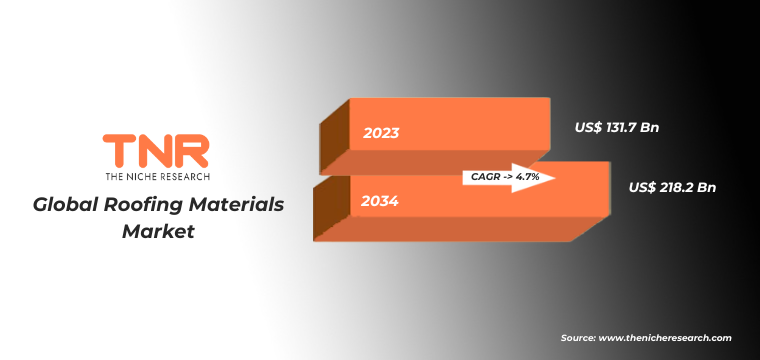
Trends in the Global Roofing Materials Market
- Rise of Sustainable Roofing Solutions: There is a growing emphasis on sustainability in construction practices, prompting the roofing materials market to innovate with eco-friendly options. This trend includes the development of recycled materials, solar reflective roofs (cool roofs), and vegetative or green roofs. These solutions not only reduce environmental impact but also align with stringent regulatory requirements aimed at reducing carbon footprints in buildings. Manufacturers are increasingly focusing on enhancing the durability and energy efficiency of their products to meet the rising demand for sustainable building materials.
- Adoption of Advanced Manufacturing Technologies: The roofing industry is witnessing a shift towards advanced manufacturing technologies such as 3D printing, automation, and digital modeling. These technologies enable precise customization, faster production cycles, and cost efficiencies in material usage. Additionally, digital tools facilitate better design capabilities, allowing architects and builders to create complex roofing structures with ease. This trend not only improves product quality and consistency but also enhances overall project efficiency and reduces construction timelines. As technology continues to evolve, these advancements are expected to drive further innovation and competitiveness within the global roofing materials market.
Tiles have captured a substantial share of the global roofing materials market, driven by their durability, aesthetic appeal, and sustainability advantages.
Clay and concrete tiles, in particular, have gained popularity due to their longevity and fire resistance, making them suitable for diverse climates. Their ability to withstand harsh weather conditions and maintain structural integrity over decades contributes to their appeal in both residential and commercial construction projects. Moreover, tiles offer architectural flexibility, allowing for varied designs that complement different building styles. In addition to their practical benefits, tiles are increasingly favored for their environmental sustainability. Many manufacturers now offer tiles made from recycled materials or produce tiles that are fully recyclable at the end of their lifecycle. This eco-friendly approach resonates with consumers and builders alike, further bolstering tiles’ market presence amidst growing demand for sustainable building materials globally.
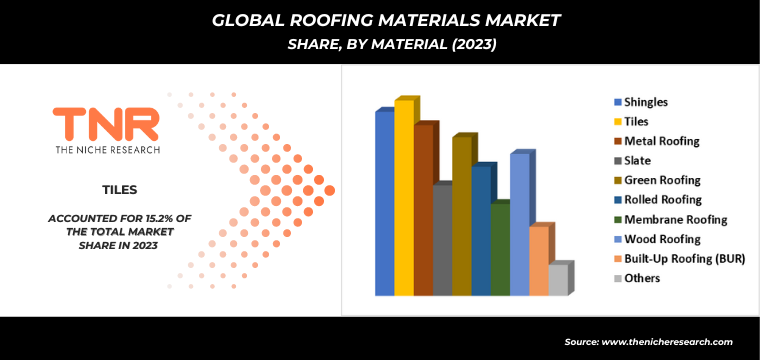
In 2023, renovation and remodeling segment by construction type category has emerged as the second-largest leading segment in the global roofing materials market. This growth is fueled by increasing refurbishment activities across residential, commercial, and industrial sectors worldwide. As existing buildings age and require upgrades, there is a heightened demand for roofing materials that offer durability, aesthetic enhancement, and improved energy efficiency. Manufacturers are responding with innovative products tailored for renovation projects, including lightweight and easy-to-install roofing solutions. This trend underscores a shift towards sustainable building practices and the importance of quality roofing materials in revitalizing existing infrastructure.

By sales channel, direct segment dominated the global roofing materials market and is expanding with a CAGR of 3.7% over the forecast timeline. This growth can be attributed to several factors, including the direct engagement between manufacturers and consumers, which fosters better control over product quality, pricing, and customer relationships. Direct sales channels allow manufacturers to offer personalized solutions and timely support, enhancing customer satisfaction. Additionally, the shift towards digital platforms and e-commerce has facilitated easier access to a wide range of roofing materials, further bolstering the direct sales segment’s prominence in the market landscape.
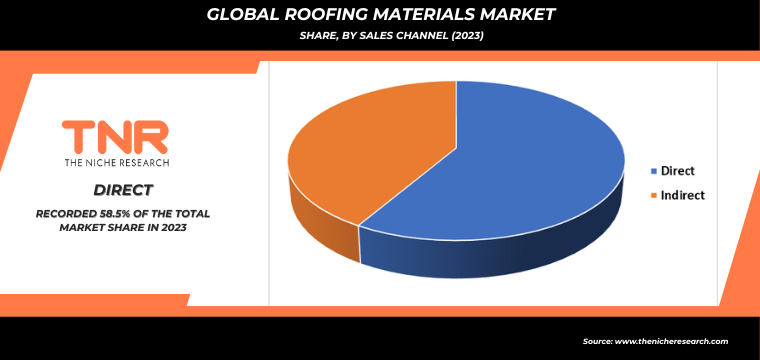
Industrial segment by end use sector is set to be fastest growing segment in the global roofing material market with a revenue share of 22.8% in 2023. This surge is driven by escalating industrial construction activities worldwide, including warehouses, manufacturing facilities, and logistics centers. These sectors demand robust roofing solutions that can withstand heavy-duty use, ensure operational continuity, and adhere to stringent safety and regulatory standards. Manufacturers are responding with specialized roofing materials that offer durability, thermal insulation, and resistance to environmental stresses. As industrial infrastructure continues to expand globally, the demand for high-performance roofing solutions is expected to sustain this segment’s rapid growth trajectory.
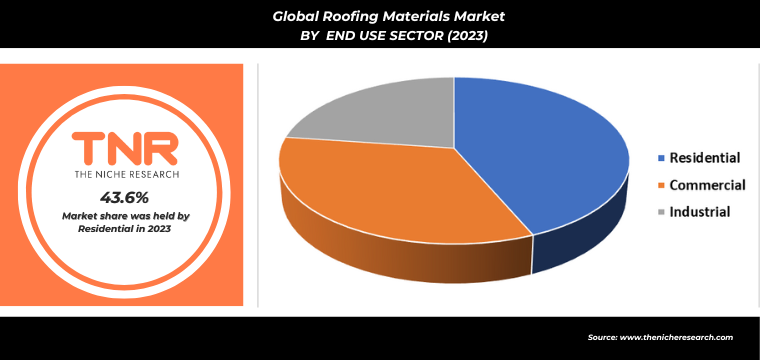
In 2023, North America solidified its position as the leading region in the roofing materials market, driven by robust construction activities and a growing focus on infrastructure upgrades and renovations. The region’s dominance is bolstered by a strong economy, favorable regulatory environment, and increasing investments in residential and commercial building sectors. Key factors contributing to North America’s market leadership include advancements in roofing technologies, such as energy-efficient materials and sustainable roofing solutions, which resonate with environmentally conscious consumers. As the construction industry continues to thrive, North America is poised to maintain its pivotal role in shaping the global roofing materials market landscape.
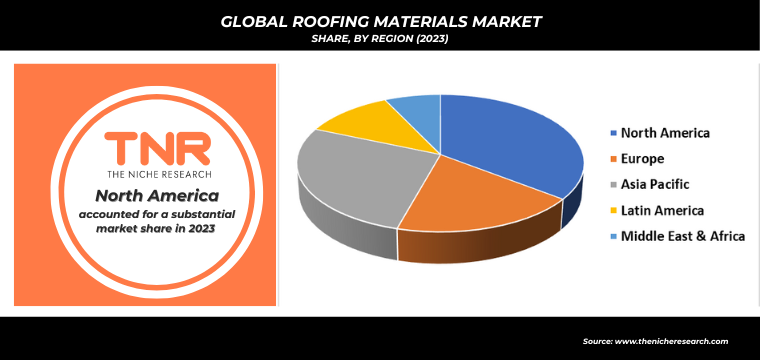
Competitive Landscape
Some of the players operating in the roofing materials market are
- Alumasc Group PLC
- Atlas Roofing Corporation
- Bauder Ltd.
- BMI
- Carlisle Companies Inc.
- CertainTeed, LLC.
- Crown Building Products LLC
- DECRA Roofing Systems Inc.
- Dow
- IKO Industries Inc.
- com
- TAMKO Building Products LLC
- Worthouse
- Other Industry Participants
Global Roofing Materials Market Scope
| Report Specifications | Details |
| Market Revenue in 2023 | US$ 131.7 Bn |
| Market Size Forecast by 2034 | US$ 218.2 Bn |
| Growth Rate (CAGR) | 4.7% |
| Historic Data | 2016 – 2022 |
| Base Year for Estimation | 2023 |
| Forecast Period | 2024 – 2034 |
| Report Inclusions | Market Size & Estimates, Market Dynamics, Competitive Scenario, Trends, Growth Factors, Market Determinants, Key Investment Segmentation, Product/Service/Solutions Benchmarking |
| Segments Covered | By Material, By Construction Type, By Sales Channel, By End Use Sector, By Region |
| Regions Covered | North America, Europe, Asia Pacific, Middle East & Africa, Latin America |
| Countries Covered | U.S., Canada, Mexico, Rest of North America, France, The UK, Spain, Germany, Italy, Nordic Countries (Denmark, Finland, Iceland, Sweden, Norway), Benelux Union (Belgium, The Netherlands, Luxembourg), Rest of Europe, China, Japan, India, New Zealand, Australia, South Korea, Southeast Asia (Indonesia, Thailand, Malaysia, Singapore, Rest of Southeast Asia), Rest of Asia Pacific, Saudi Arabia, UAE, Egypt, Kuwait, South Africa, Rest of Middle East & Africa, Brazil, Argentina, Rest of Latin America |
| Key Players | Alumasc Group PLC, Atlas Roofing Corporation, Bauder Ltd, BMI, Carlisle Companies Inc., CertainTeed, LLC. , Crown Building Products LLC, DECRA Roofing Systems Inc., Dow, IKO Industries Inc., Roofle.com, TAMKO Building Products LLC, Worthouse, Other Industry Participants |
| Customization Scope | Customization allows for the inclusion/modification of content pertaining to geographical regions, countries, and specific market segments. |
| Pricing & Procurement Options | Explore purchase options tailored to your specific research requirements |
| Contact Details | Consult With Our Expert
Japan (Toll-Free): +81 663-386-8111 South Korea (Toll-Free): +82-808- 703-126 Saudi Arabia (Toll-Free): +966 800-850-1643 United Kingdom: +44 753-710-5080 United States: +1 302-232-5106 E-mail: askanexpert@thenicheresearch.com
|
Global Roofing Materials Market
By Material
- Shingles
- Asphalt Shingles
- Synthetic Composite Shingles
- Tiles
- Clay
- Concrete
- Solar
- Metal Roofing
- Slate
- Green Roofing
- Rolled Roofing
- Membrane Roofing
- Wood Roofing
- Built-Up Roofing (BUR)
- Others
By Construction Type
- New Construction
- Renovation and Remodeling
By Sales Channel
- Direct
- Indirect
By End Use Sector
- Residential
- Commercial
- Industrial
By Region
- North America (U.S., Canada, Mexico, Rest of North America)
- Europe (France, The UK, Spain, Germany, Italy, Nordic Countries (Denmark, Finland, Iceland, Sweden, Norway), Benelux Union (Belgium, The Netherlands, Luxembourg), Rest of Europe)
- Asia Pacific (China, Japan, India, New Zealand, Australia, South Korea, Southeast Asia (Indonesia, Thailand, Malaysia, Singapore, Rest of Southeast Asia), Rest of Asia Pacific)
- Middle East & Africa (Saudi Arabia, UAE, Egypt, Kuwait, South Africa, Rest of Middle East & Africa)
- Latin America (Brazil, Argentina, Rest of Latin America)
Report Layout:
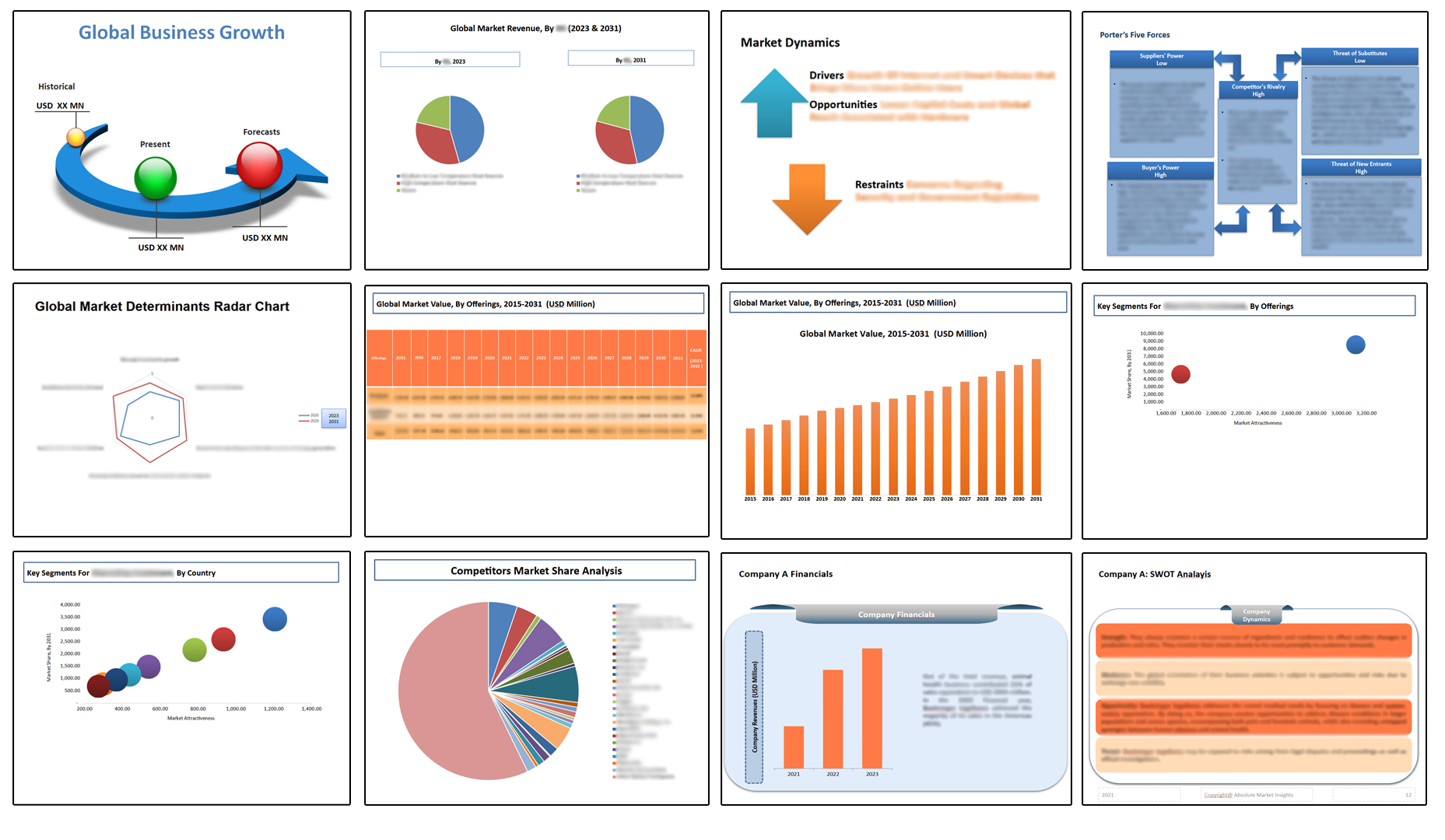
Table of Contents
Note: This ToC is tentative and can be changed according to the research study conducted during the course of report completion.
**Exclusive for Multi-User and Enterprise User.
Global Roofing Materials Market
By Material
- Shingles
- Asphalt Shingles
- Synthetic Composite Shingles
- Tiles
- Clay
- Concrete
- Solar
- Metal Roofing
- Slate
- Green Roofing
- Rolled Roofing
- Membrane Roofing
- Wood Roofing
- Built-Up Roofing (BUR)
- Others
By Construction Type
- New Construction
- Renovation and Remodeling
By Sales Channel
- Direct
- Indirect
By End Use Sector
- Residential
- Commercial
- Industrial
By Region
- North America (U.S., Canada, Mexico, Rest of North America)
- Europe (France, The UK, Spain, Germany, Italy, Nordic Countries (Denmark, Finland, Iceland, Sweden, Norway), Benelux Union (Belgium, The Netherlands, Luxembourg), Rest of Europe)
- Asia Pacific (China, Japan, India, New Zealand, Australia, South Korea, Southeast Asia (Indonesia, Thailand, Malaysia, Singapore, Rest of Southeast Asia), Rest of Asia Pacific)
- Middle East & Africa (Saudi Arabia, UAE, Egypt, Kuwait, South Africa, Rest of Middle East & Africa)
- Latin America (Brazil, Argentina, Rest of Latin America)
The Niche Research approach encompasses both primary and secondary research methods to provide comprehensive insights. While primary research is the cornerstone of our studies, we also incorporate secondary research sources such as company annual reports, premium industry databases, press releases, industry journals, and white papers.
Within our primary research, we actively engage with various industry stakeholders, conducting paid interviews and surveys. Our meticulous analysis extends to every market participant in major countries, allowing us to thoroughly examine their portfolios, calculate market shares, and segment revenues.
Our data collection primarily focuses on individual countries within our research scope, enabling us to estimate regional market sizes. Typically, we employ a bottom-up approach, meticulously tracking trends in different countries. We analyze growth drivers, constraints, technological innovations, and opportunities for each country, ultimately arriving at regional figures.Our process begins by examining the growth prospects of each country. Building upon these insights, we project growth and trends for the entire region. Finally, we utilize our proprietary model to refine estimations and forecasts.
Our data validation standards are integral to ensuring the reliability and accuracy of our research findings. Here’s a breakdown of our data validation processes and the stakeholders we engage with during our primary research:
- Supply Side Analysis: We initiate a supply side analysis by directly contacting market participants, through telephonic interviews and questionnaires containing both open-ended and close-ended questions. We gather information on their portfolios, segment revenues, developments, and growth strategies.
- Demand Side Analysis: To gain insights into adoption trends and consumer preferences, we reach out to target customers and users (non-vendors). This information forms a vital part of the qualitative analysis section of our reports, covering market dynamics, adoption trends, consumer behavior, spending patterns, and other related aspects.
- Consultant Insights: We tap into the expertise of our partner consultants from around the world to obtain their unique viewpoints and perspectives. Their insights contribute to a well-rounded understanding of the markets under investigation.
- In-House Validation: To ensure data accuracy and reliability, we conduct cross-validation of data points and information through our in-house team of consultants and utilize advanced data modeling tools for thorough verification.
The forecasts we provide are based on a comprehensive assessment of various factors, including:
- Market Trends and Past Performance (Last Five Years): We accurately analyze market trends and performance data from preceding five years to identify historical patterns and understand the market’s evolution.
- Historical Performance and Growth of Market Participants: We assess the historical performance and growth trajectories of key market participants. This analysis provides insights into the competitive landscape and individual company strategies.
- Market Determinants Impact Analysis (Next Eight Years): We conduct a rigorous analysis of the factors that are projected to influence the market over the next eight years. This includes assessing both internal and external determinants that can shape market dynamics.
- Drivers and Challenges for the Forecast Period:Identify the factors expected to drive market growth during the forecast period, as well as the challenges that the industry may face. This analysis aids in deriving an accurate growth rate projection.
- New Acquisitions, Collaborations, or Partnerships: We keep a close watch on any new acquisitions, collaborations, or partnerships within the industry. These developments can have a significant impact on market dynamics and competitiveness.
- Macro and Micro Factors Analysis:A thorough examination of both macro-level factors (e.g., economic trends, regulatory changes) and micro-level factors (e.g., technological advancements, consumer preferences) that may influence the market during the forecast period.
- End-User Sentiment Analysis: To understand the market from the end-user perspective, we conduct sentiment analysis. This involves assessing the sentiment, preferences, and feedback of the end-users, which can provide valuable insights into market trends.
- Perspective of Primary Participants: Insights gathered directly from primary research participants play a crucial role in shaping our forecasts. Their perspectives and experiences provide valuable qualitative data.
- Year-on-Year Growth Trend: We utilize a year-on-year growth trend based on historical market growth and expected future trends. This helps in formulating our growth projections, aligning them with the market’s historical performance.
Research process adopted by TNR involves multiple stages, including data collection, validation, quality checks, and presentation. It’s crucial that the data and information we provide add value to your existing market understanding and expertise. We have also established partnerships with business consulting, research, and survey organizations across regions and globally to collaborate on regional analysis and data validation, ensuring the highest level of accuracy and reliability in our reports.















